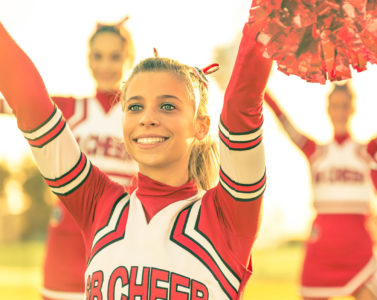 Anyone who says that cheerleading is not a physical activity has never flipped through the air or tried to catch a person out of the air. You might not think cheerleading is that dangerous of a sport, but according to the National Center for Catastrophic Sports Injury Research at North Carolina, 65 percent of all catastrophic youth sports injuries occur in cheerleading.
Anyone who says that cheerleading is not a physical activity has never flipped through the air or tried to catch a person out of the air. You might not think cheerleading is that dangerous of a sport, but according to the National Center for Catastrophic Sports Injury Research at North Carolina, 65 percent of all catastrophic youth sports injuries occur in cheerleading.
We’re not going to focus on traumatic brain injuries or dislocated knees that can sometimes be the result of a stunt gone wrong. Instead, we’re going to take a look at how cheerleading can take a toll on your child’s feet. Today, we take a closer look at the association between foot injuries and cheerleading.
Types Of Foot Injuries During Cheerleading
In cheerleading, we often see two distinct types of injuries. There are the acute trauma injuries and the overuse injuries. Here’s a closer look at the two injury types.
Acute Injuries – Acute trauma injuries are injuries that occur when an overwhelming force is placed on the foot. Whether it’s from a fall or a missed step, acute trauma injuries in cheerleading include sprained ankles, ankle or foot fractures, heel fractures, broken toes, and deep bruises. These injuries can heal with conservative treatment options, although fractures should be evaluated by a foot specialist to see if hardware or a surgical procedure is needed to stabilize the area.
Overuse Injuries – Practice makes perfect, and it’s not uncommon for cheerleaders to practice multiple hours a day, five or more days a week. This can overwork certain muscle groups and structures in our feet, and it can lead to injuries like stress fractures, shin splints, calf strains, peroneal tendinitis, cramps, muscle spasms and blisters. These injuries often get better with rest, but they can return with activity, so treatment should be paired with targeted physical therapy and strength training exercises.
Preventing Foot Injuries During Cheerleading
Preventing foot injuries during cheerleading comes down to knowing the types of injuries you are susceptible to and taking measures to prevent against them. For instance, while you’re susceptible to ankle fractures during a flip routine, there’s not a lot you can do to prevent it from happening outside of making sure you’ve practiced the routine in the foam pit and you trust the people catching you. For other injuries, there are more preventative steps available, like:
- Taking ample time to warm up and cool down before and after practice or a competition.
- Practice, but don’t overdo it.
- Do some foot exercises.
- Practice in a safe place on a safe floor mat.
- Wear the right shoes both during and outside of practice.
- Head to a doctor’s office or a trainer’s office if foot pain begins to develop.
- Be healthy outside of cheerleading, including getting enough sleep and eating a healthy diet.